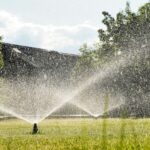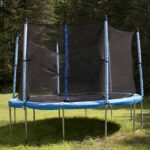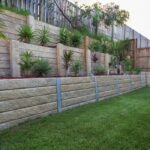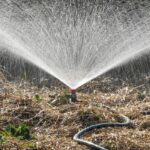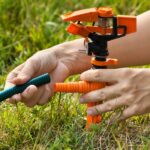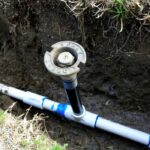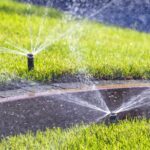There are many variables to consider before installing a sprinkler system. Climate, lawn size, and whether you want to do the work yourself are all essential factors to keep in mind. But how much does it all cost? Which factors influence the final price? And how do you decide which system is right for your home?
The cost of professional sprinkler system installation varies based on the system size and type. For the average-sized yard, an in-ground system will cost between $2,000 and $4,500 to install, while an above-ground system will cost around $2,000. Doing it yourself can cut up to half of the costs.
Let’s take a closer look at the price of installing a sprinkler system and what goes into the total cost. We’ll also review some tips for choosing the right system for your home and consider whether it’s worth hiring a professional installer or doing this job yourself.
How Does a Sprinkler System Work?
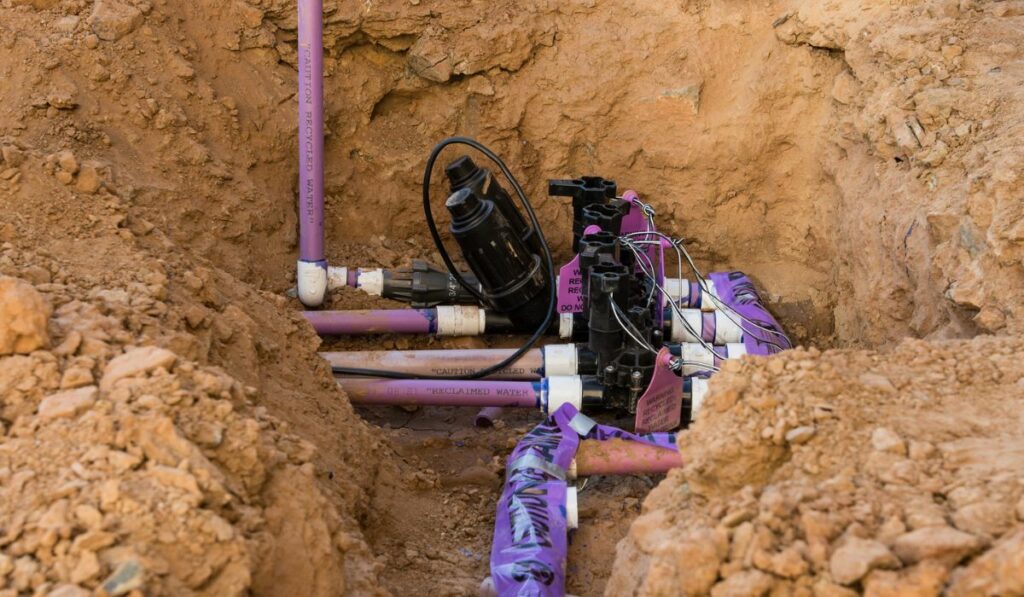
Sprinkler systems have two main parts: the sprinkler head and the irrigation pipe. The sprinkler head is attached to the irrigation pipe and sprays water onto the lawn.
The irrigation pipe is buried underground or placed on the ground surface and carries water to the sprinkler heads, depending on the type of system.
What Are the Different Types of Sprinkler Systems?
There are a few different sprinkler systems: in-ground, above-ground, and drip systems.
In-Ground Sprinkler Systems
An in-ground sprinkler system is the most common type of sprinkler system. It consists of a network of pipes buried in the ground. When you turn on the system, water flows through the pipes and out the sprinkler heads, watering the lawn.
There are automatic and manual in-ground sprinkler systems. An automatic system works with a programmed controller to turn the system on and off at specific times. Manual systems require you to turn the system on and off yourself.
Above-Ground Sprinkler Systems
An above-ground sprinkler system connects a hose bib and is placed on top of the ground. Water flows through the pipes to the sprinkler heads to water the lawn.
Fixed spray, rotating turret, and oscillating are some available types of above-ground sprinkler heads.
Fixed spray systems have a single sprinkler head that sprays water in a fixed pattern. Rotating turret systems have several sprinkler heads that rotate around a central point, providing even coverage over a large area. Oscillating systems move back and forth across the lawn, providing coverage in both directions.
Drip Sprinkler Systems
A drip system is a type of irrigation system that delivers water directly to the roots of plants via small tubes or hoses. Drip systems like this one (on Amazon) are popular for gardens and potted plants because they conserve water and are gentle on plants.
How Much Does It Cost to Install a Sprinkler System?
The cost of installing a sprinkler system varies depending on the type of system, the size of the lawn, and several other factors. On average, a residential yard is about a quarter of an acre, or approximately 10,000 square feet.
In-ground systems are the most expensive, followed by above-ground systems. Drip irrigation systems are usually the most affordable option.
An in-ground sprinkler system for a lawn size of a quarter of an acre can cost between $2,000 and $4,500. The average cost of installing an above-ground sprinkler system for a lawn this size is around $2,000.
Drip system costs vary depending on the design. A basic drip system for a small garden can start at around $300, while a more complex one for a large garden can cost upwards of several thousand dollars.
Additional costs may include the price of materials, such as irrigation pipes and sprinkler heads, and the cost of labor if you hire a professional to install the system. Most professionals charge around $50-75 per hour for installation services.
What Factors Go Into the Installation Costs?
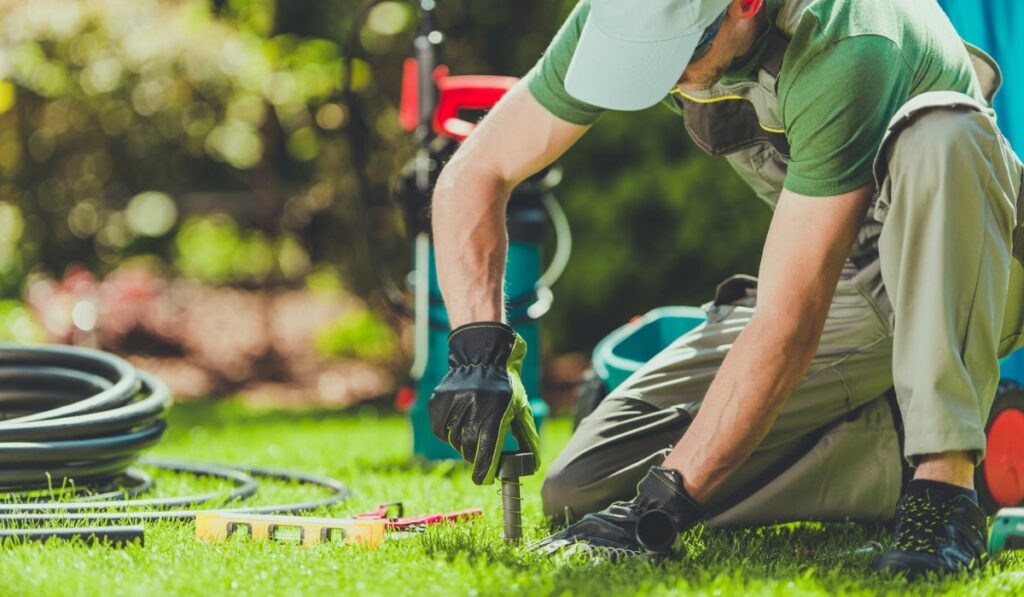
When installing a sprinkler system, many factors will affect the final cost. The yard size, the type of irrigation system, and the contractor’s fees are just a few things that will affect the total price.
Yard Size
A small yard will require less piping and fewer sprinkler heads, while a large yard will need more materials and labor. If you have a bigger yard, you may also need to purchase a larger water pump to deliver enough water pressure to the sprinkler heads.
Type of System
In-ground systems are more expensive than above-ground systems because they require excavating and trenching. Above-ground systems are less costly since they can be installed without digging, though they require more maintenance over time.
Drip systems can be inexpensive or very costly, depending on the size of the system and the complexity of the design.
Pipe Materials
The irrigation pipe is one of the most important factors in the cost of a sprinkler system. PVC pipe is the most common type of irrigation pipe and is relatively inexpensive. Polyethylene pipe is another option, and it’s more flexible than PVC but also more expensive.
When choosing pipe materials, consider the climate in your area and the type of soil in your yard, as certain materials are better suited for specific conditions.
Sprinkler Heads and Other Components
The type of sprinkler heads you choose will also affect the cost of the system. Fixed spray heads are the most common and least expensive option.
Rotating turret heads (on Amazon) are more expensive but provides more even coverage. You can achieve a broader range of coverage with oscillating heads, which are the most expensive.
After determining the best way to water your lawn, you’ll need to purchase the components for your system. Most systems will require:
- A water source (well, city water, etc.)
- A water pump (if using a well)
- A pressure regulator
- A Backflow preventer (on Amazon)
- Filter
- Valves
- Pipe
- Wire
You may also need additional components depending on the size and layout of your yard and the type of system you’re installing.
Contractor Fees
When hiring a sprinkler installation professional, you must consider their fees. Most professionals charge around $50-75 per hour for installation services. Some companies may also charge a flat fee for installation.
When getting quotes from contractors, ask what their fees include. For example, some contractors may charge extra for permits and materials, while others will include these costs in their quotes.
Permits
Depending on your location, you may need a permit before installing a sprinkler system. Permits can cost $100 or more, so check with your local building department to see if a permit is required and how much it will cost. An inspection may also be necessary, which can add to the cost.
If you have a homeowners’ association, there may be restrictions on the type or size of sprinkler system you can install. Be sure to check with your association before starting any work to avoid fines or other penalties.
Additional Considerations
A few other factors can affect the cost of installing a sprinkler system. If you have a well, you may need to purchase a water pump to deliver enough water pressure to the sprinkler heads.
If you live in an area with harsh winters, you may need to purchase a freeze-proof valve to prevent the pipes from freezing and bursting. You may need additional parts to ensure proper drainage if your property has a slope.
The best way to get an accurate estimate of the cost of installing a sprinkler system is to contact a local contractor. They will assess your yard and provide you with a detailed quote.
What to Consider Before Installing a Sprinkler System

When considering installing a sprinkler system, there are a few things to consider.
Climate
If you live in an area with frequent droughts, installing a sprinkler system may not be worth installing, as it can be wasteful. Check with your local water utility company to find out if there are any restrictions on outdoor watering.
In some areas, watering during certain times of the day or using a specific type of sprinkler head may be prohibited.
Yard Type
Your yard type will also affect how effective a sprinkler system will be. If you have a lot of trees, shrubs, and other landscaping features, installing underground sprinklers may not be possible. In this case, you’ll likely need to opt for an above-ground system.
It’s also important to consider the slope of your yard when deciding on a sprinkler system. A hilly yard may not benefit from an underground system, as water can pool in low-lying areas and run off before reaching the roots of your grass.
Yard Size
Watering a small lawn with a hose and sprinkler is usually enough while watering a larger yard will require a more elaborate system. So, always consider if it’s worth installing a sprinkler system for your lawn size or if a simpler solution like hand-watering will suffice. A larger lawn will, of course, require more time to hand-water.
Irrigation Zone Layout
Once you’ve decided that a sprinkler system is suitable for your yard, you’ll need to have an irrigation zone layout drawn up to help determine the best way to water your lawn without over-watering or under-watering certain areas.
Your local nursery or garden center can usually provide a basic irrigation zone layout. You can also find irrigation zone layouts online or in gardening books.
Soil Type
The soil in your yard will also affect how well a sprinkler system works.
Sandy soil drains quickly and doesn’t hold moisture well, so you’ll need to water more frequently. Clay soil holds moisture longer, so you won’t need to water as often. Both clay and sandy soils can be difficult to water evenly, so you may need a more elaborate system to ensure proper watering.
Sandy soil is easier to dig through than clay soil, so installing the system will require less labor.
Cost
As we described above, the price of the system will depend on the size and complexity of the system, as well as any extras you may want, such as automatic timers or rain sensors (on Amazon).
You’ll also need to factor in the cost of professional installation, which can range from a few hundred dollars to over a thousand. If you’re handy and have some experience with plumbing, you may be able to save money by installing the system yourself.
Longevity
Most in-ground and above-ground systems have a lifespan of about 15-20 years. When choosing a system, you should also consider replacement and repair costs.
For example, above-ground sprinklers may not be the best option if you live in an area with high winds, as they can easily blow over. And if you have a lot of trees on your property, their roots can grow and damage the underground piping of a sprinkler system.
Knowing the potential lifespan of a sprinkler system and what can shorten that lifespan will help you decide if it’s the ideal investment for your home.
DIY vs. Hiring a Professional: Which Is Best?
When installing a new sprinkler system, you have two options: do it yourself (DIY) or hire a professional. Both have their pros and cons, which we’ll look at below.
The Pros and Cons of DIY Sprinkler Installation
DIY installation is usually less expensive than hiring a professional. However, it can be more time-consuming and difficult, especially if you’re unfamiliar with plumbing.
That said, most people aren’t equipped to install their own sprinkler system by themselves because of the extensive nature of the project. Without experience, it’s easy to make mistakes that can be both costly and time-consuming to fix.
Also, the repair costs will be entirely on you if something goes wrong with the system after you’ve installed it.
The Pros and Cons of Professional Sprinkler Installation
Hiring a professional will give you peace of mind that they will install the system quickly and efficiently. And if something goes wrong with the system, the installer’s warranty will typically cover the repair costs.
Of course, there are some drawbacks to hiring a professional as well. It’s more expensive than doing it yourself, and if you have a problem with the system after installation, you’ll likely have to work with the installer to get it fixed — which may be a hassle.
So, which is the best option — DIY or professional installation? Ultimately, the decision comes down to your budget, your skill level, and how much time you’re willing to spend on the project.
If you’re handy and have some experience with plumbing, DIY installation can be a great option. But if you’re not confident in your abilities or don’t want to risk making mistakes, it’s best to leave it to the professionals.

